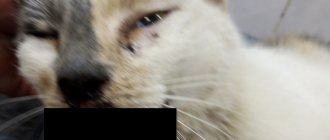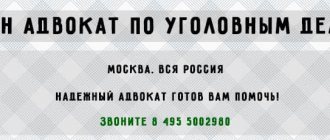ST 245 of the Criminal Code of the Russian Federation.
1. Cruel treatment of an animal for the purpose of causing it pain and (or) suffering, as well as for hooligan motives or mercenary motives, resulting in its death or injury, -
shall be punishable by a fine in the amount of up to eighty thousand rubles, or in the amount of the wages or other income of the convicted person for a period of up to six months, or by compulsory labor for a term of up to three hundred sixty hours, or by corrective labor for a term of up to one year, or by restriction of liberty for a term of up to one year. , or arrest for a term of up to six months, or imprisonment for a term of up to three years.
2. The same act committed:
a) by a group of persons, a group of persons by prior conspiracy or an organized group;
b) in the presence of a minor;
c) using sadistic methods;
d) with public demonstration, including in the media or information and telecommunication networks (including the Internet);
e) in relation to several animals, -
shall be punishable by a fine in the amount of one hundred thousand to three hundred thousand rubles, or in the amount of the wages or other income of the convicted person for a period of one to two years, or by correctional labor for a term of up to two years, or by forced labor for a term of up to five years, or by imprisonment. for a period of three to five years.
Commentary to Art. 245 Criminal Code
1. The subject of encroachment is animals, regardless of their form of ownership and their classification as wild, domestic, or kept in captivity or semi-free conditions.
2. Mandatory signs of the objective side are actions, consequences and a causal relationship between them.
Actions can be expressed in cruelty to animals (systematic beating of animals, causing pain, suffering, mutilation, wounds, leaving without food and water, self-harm, conducting unscientific experiments, etc.).
The consequences are the death of the animal or injury to it.
3. An act is punishable only if there are alternatively indicated signs of an objective or subjective side: a) sadistic methods - especially sophisticated cruelty to animals (painful killing, torture, torment, etc.), associated with the subject of the crime receiving satisfaction from torturing the animal; b) committing a crime in the presence of children under the age of 14; c) selfish motives (the motive for committing a crime is the desire to obtain material gain or get rid of material costs; d) hooligan motives (the desire of a person to show disrespect for society, moral and ethical standards, the desire to demonstrate his disdain for others).
Features of the crime
The protection of animals from cruelty is recognized internationally. According to European conventions in this area, a person has a moral duty to his smaller brothers, he is obliged to treat them humanely, not cause suffering, and protect their health. Russian legislation also prohibits cruelty to animals.
These crimes are distinguished by the fact that the “victims” are animals who themselves cannot complain about inappropriate behavior towards them to the police. Law enforcement agencies are usually reported by concerned passers-by, neighbors in the house, or on the landing. It is difficult to prove the commission of such a crime without the presence of video materials, so cases under Article 245 of the Criminal Code were rarely initiated and reached the court.
Interesting! Some of the first regulations known to mankind to protect animals from cruelty were published in Japan in the 17th century and were aimed at protecting horses, dogs, cats, cows, turtles and other living creatures. The punishment for bullying was severe, including the death penalty. Download for viewing and printing:
Article 245 of the Criminal Code of the Russian Federation dated June 13, 1996 N 63-FZ (as amended on February 19, 2018)
Concept and characteristics
Abuse means the following actions (or inaction):
- intentionally aimed at causing pain and suffering to an animal (torture, beatings, suffocation, drowning, keeping without food and water);
- from hooliganism (beatings filmed on video; pitting animals);
- out of selfish interest (for example, in order to obtain fur for sale, they skin a living animal; they organize animal fights with the acceptance of monetary bets).
Similar actions may also include:
- the use of animals in unscientific or scientific experiments causing unnecessary suffering;
- organizing competitions during which animals (for example, dogs) are pitted against each other, which leads to the death or injury of one of them;
- training that causes suffering.
Composition of the crime and legal norms
Administrative responsibility for inappropriate treatment of pets is established by the constituent entities of the Russian Federation independently.
Criminal punishment for cruelty to animals is provided for in Article 245 of the Criminal Code of the Russian Federation. The subject of an unlawful act is a citizen who has reached the age of sixteen.
The subjective side is characterized by the direct or indirect intent of the criminal. This means that the person knows about the occurrence of negative consequences and desires their occurrence or allows negative consequences to occur.
The objects are wild and domestic animals, as well as stray animals, which are the target of the criminal’s illegal actions.
The objective side is cruel treatment.
This crime is considered completed when death or injury occurs. If the unlawful act is not completed due to factors beyond the control of the criminal (for example, passers-by interfered with him), then we will talk about liability for attempted cruelty.
Second commentary to Art. 245 of the Criminal Code of the Russian Federation
1. The immediate object is public morality in the sphere of humane treatment of animals, which means domestic, wild and captive mammals, birds and other animals.
2. The objective side of the crime consists of actions consisting of cruelty to animals, i.e. in their systematic beatings, inhumane conditions of detention (in cold or heat), in long-term deprivation of food and water, etc.
A mandatory sign of the objective side is the consequences in the form of death or injury to an animal subjected to cruel treatment. On this basis, the organization of dog, cock and other fights that lead to the death or injury of animals should also be recognized as cruel treatment.
3. A prerequisite for criminal liability for cruelty to animals is (regardless of the motives of the perpetrator) the commission of this act using sadistic methods, which are understood as particularly humiliating methods of causing suffering to animals, or its commission in the presence of minors, i.e. . persons under the age of 14 years.
4. The crime is considered completed from the moment the consequences specified in the law occur—the death or injury of the animal.
5. The subjective side of the crime is characterized by the intent and purpose of causing pain and (or) suffering to the animal.
6. Alternatively, the mandatory features of this crime are its motives: selfish (see comments to Chapter 21) or hooliganism (see comments to Article 213 of the Criminal Code).
7. Selfish motives are typical when organizing fights between animals, when spectators are charged a fee or bets are accepted on the winner.
8. Qualified types of crime (Part 2) are characterized by its commission:
a) a group of persons, a group of persons by prior conspiracy or an organized group (see Parts 2 and 3 of Article 35 of the Criminal Code);
b) in the presence of a minor, i.e. at least one person under the age of 14; c) using sadistic methods (for example, self-mutilation, cutting off the head, burning alive);
d) with public demonstration, including in the media or information and telecommunication networks (including the Internet);
e) in relation to several animals (the same species or different species; simultaneously or sequentially).
Problems of law enforcement to protect animals from cruelty
The biggest problem, I believe, is the absolute lack of understanding on the part of the legislator of the close relationship between a person’s attitude to the surrounding world and the attitude within human society, i.e., the problem in understanding the need to protect one’s habitat, including animals, gives rise to clumsy, completely incorrect formulations of relevant legal norms. For example, the disposition of Art. 245 of the Criminal Code of the Russian Federation “Cruelty to animals” does not provide an understanding of what relates to cruelty to animals; only a listing of the occurrence of socially dangerous consequences is given - causing injury or death to an animal and the subjective side, as direct intent in the presence of motives - hooliganism, or for selfish reasons, sadistic methods or in the presence of minors.
Even a superficial analysis of this article allows us to conclude that it is quite difficult to prosecute a guilty person for cruelty to animals due to incorrect wording; Thus, it will be impossible to bring to justice a person who carelessly locked an animal in a car parked in the sun, as a result of which the animal dies from heat stroke, or who keeps an animal on a leash and leaves it for a long time without food and water. But even in cases where it would seem that the crime is obvious, it is not always possible to bring the perpetrator to justice.
In this regard, the case of Khudoyarov is indicative, who, while driving around Moscow in his car, used an air rifle to shoot dogs that not only did not pose any threat to others, but also, obviously, to the defendant, who had owners.
It is significant that at the stage of the preliminary investigation, Khudoyarov admitted his guilt, and, in the presence of his defense attorney, filed a motion to hold a trial in a special manner.
In this trial, representing the interests of the victims, I perfectly understood that the case would end with a small fine, after which Khudoyarov would again continue killing defenseless animals, especially since earlier he had already been held administratively liable under Article 20.13 of the Code of Administrative Offenses of the Russian Federation for shooting at crows in public place.
Therefore, I decided to take a risk and, on my advice, the victims did not give their consent to hear the case in a special manner. This is where the problems began, connected, firstly, with gaps in the current legislation; secondly, with the quite predictable “deterioration in health” of the accused, and, as a consequence of this, his failure to appear at court hearings.
The case, from the stage of judicial investigation, was returned to the prosecutor on the basis of paragraph 1 of part 1 of Art. 237 Code of Criminal Procedure of the Russian Federation. Appeals and an appeal presentation from the prosecutor were filed against the decision of the magistrate, and, after consideration of the case by the appellate instance, cassation complaints and a cassation presentation were filed.
The Judicial Collegium for Criminal Cases of the Moscow City Court, leaving in force the Resolution of the Cheryomushkinsky District Court of the city of Moscow dated June 29, 2011, which amended the resolution of the magistrate of the judicial district N 429 of the Cheryomushki district of the city of Moscow dated May 5, 2011 on the return of the criminal case against Kh. Cheryomushkinsky interdistrict prosecutor of the city of Moscow, motivated the cassation ruling by the fact that: “... the objective side of the crime provided for in Art. 245 of the Criminal Code of the Russian Federation, is expressed in cruelty to animals, resulting in socially dangerous consequences - their death or injury. The subjective side of the crime under Art. 245 of the Criminal Code of the Russian Federation, is characterized by guilt in the form of direct intent, when the guilty person is aware that he is torturing an animal, causing it injury or death, and desires this. A mandatory feature of the subjective side is the motivation of the crime. The law provides for two mandatory motives: hooligan and selfish motives. A crime will only occur if the specified death or injury was accompanied by appropriate motivation (hooligan or mercenary motives) or took place under certain conditions (committed using sadistic methods or in the presence of minors). In this criminal case, neither the form of guilt nor the mandatory motive for the crimes committed are described. Hooligan motives are also not disclosed in the description of the criminal act.” That is, according to the Moscow City Court, shooting to cause death or injury with a pneumatic weapon in a public place (one dog was mutilated near a public transport stop) is not an act committed with hooligan motives. Ultimately, in January 2013, the case was dismissed due to the expiration of the statute of limitations, i.e., on non-exonerating grounds.
The process was widely covered in the media, therefore, the effect I needed was achieved - instead of a quiet conclusion to the case with a modest fine, Khudoyarov’s personality became widely known, especially since photographs of him can still be found on the Internet, respectively, and assessment of his actions from the outside the majority was sharply negative. Due to the lack of a uniform practice in this category of cases, courts can take the most unexpected positions when classifying crimes related to cruelty to animals.
Thus, the Supreme Court of the Russian Federation, by its Ruling of March 12, 2002 No. 41-kpo01-156, partially changed the verdict of the Rostov Regional Court of September 18, 2001 in relation to B., reclassifying his actions from Art. 245 part 2 of the Criminal Code of the Russian Federation at Art. 167 part 1 of the Criminal Code of the Russian Federation, motivating his decision by the fact that B. poisoned the dog in order to remove obstacles when committing a robbery attack on the family of K., K.A.
Although, in my opinion, B. acted by giving poison to the dog, realized that this could lead to its death and wanted this in order to commit a crime for personal gain, i.e., here we can agree with the motives of the verdict of the trial court. Many problems arise when interpreting the concept of “sadistic methods”, since the concept of “sadism” itself is not legal, but more related to psychiatry and is most often used to designate one of the forms of sexual perversion.
Therefore, the courts are forced to take on the unusual function of experts, deciding what methods were used by the guilty person in causing the death of an animal. Thus, the Royal Court of the Moscow Region convicted V. under paragraphs. “a” and “b” part 2 art. 158 of the Criminal Code of the Russian Federation and Part 1 of Art. 245 of the Criminal Code of the Russian Federation for the fact that he, together with G., entered the apartment in the absence of the owners, and while G. was looking for valuables with the aim of stealing them, he killed the cat with a knife.
The Moscow Regional Court upheld the verdict and rejected the prosecutor's appeal.
Arbitrage practice
.
In judicial practice, cases of cruel treatment are not frequent due to the lack of evidence in the case. But still, such examples are available in the book of meetings; most of the examples are found in Part 1, where the punishment is not too severe.
Let's give an example from part 2: while visiting, citizen Chernov killed the cat of the owner of the house, citizen Yuryev, because the cat stole a piece of sausage from the table. At the time of the massacre of the cat, Yuryev’s young son, who was 8 years old at the time of the crime, was present in the room.
The qualification of the case under Part 2 was based on:
- Based on the fact that there was a child in the house.
- The fact that the crime was committed out of hooligan motives.
The presence of a minor child automatically transfers the case to part 2, so citizen Chernov was sentenced to compulsory labor for a period of 1 year.
Comment on the article
Usually, the article for cruelty to animals requires clear provision of evidence in the case, since this is the only way to punish the culprit. To do this, the beating of the animal must be recorded, and it is imperative that the pet was either injured or died due to the recent actions of the defendant.
In addition, a motive is needed, which is determined by voting between the jurors; if it is a jury trial by which the crime occurred, it can be:
- hooligan;
- selfish.
A hooligan motive is established if the reprisal against an animal, for example a dog or cat, occurred for the purpose of personal satisfaction or simply from hooligan thoughts, for example, the culprit thought that the pet had bad behavior.
At the same time, the hooligan motive can be applied in a situation where the bullying was against someone else’s pet. In this case, the culprit will still be punished under Art. 167. The court will determine the final measure of responsibility based on the totality of the crimes charged.
If there was a mercenary motive, when an animal was abused or killed in order to obtain money, then the punishment under the article becomes more severe and changes to part two. In addition, if the animal is someone else’s property, then the culprit can also be judged according to Art. 167.
The concept of “animal” in law
In Russian legislation, the concept of animal includes all types of organisms that cannot speak and act meaningfully, living in natural or artificial fauna. The purpose of the law is to protect the rights of animals that these species have along with humans from violence against their persons, as well as to preserve every life.
But the article of the Criminal Code of the Russian Federation, cruelty to animals, does not apply to some types of living organisms, namely:
- on fish;
- on amphibians, such as frogs;
- on reptiles, such as snakes;
- on invertebrates such as spiders or worms.
This exception is due to the fact that the state of the Russian Federation officially restricts fish for fishing for food purposes, and other species of animals can pose a real danger to humans and become wild, showing aggression, even if the person does not expect an attack and does not provoke the animal in any way.
Reproduction, mainly of forest animal species, is controlled separately by the state. Usually, forest workers determine an increase in the number of livestock of certain animals; for the safety of nearby settlements and people, special permission is issued to hunters for shooting animals for such types of animals. In this case, the law on cruelty to animals does not apply, but hunters must kill the animal and not cause it torture. Hunters can take the killed animal for their own purposes.
The law aims to protect the animal, depending on whether it is fully domesticated and lives with humans or is a wild animal, but raised in artificial conditions and kept in a zoo. In any case, cruelty to animals is strictly prohibited and punishable by law.








